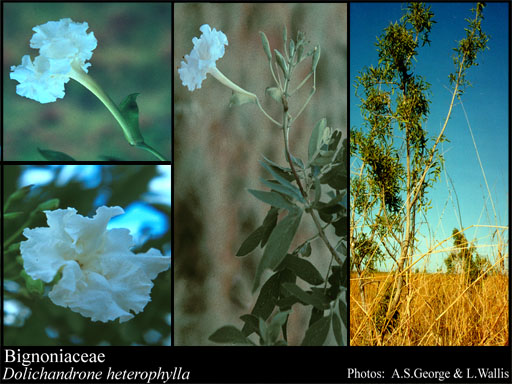- Reference
- Gen.Pl. [Jussieu] 137 (1789)
- Name Status
- Current







Scientific Description
Common name. Trumpet-creeper Family.
Habit and leaf form. Trees, or shrubs, or lianas, or herbs (rarely). Self supporting, or climbing; when climbing stem twiners, or tendril climbers (via modified terminal leaflets), or root climbers. The twiners twining anticlockwise (Tecoma). Leaves opposite (mostly), or whorled, or alternate (rarely, then spiral); petiolate; non-sheathing; compound (usually), or simple; pinnate, or palmate, or bipinnate, or multiply compound. Leaf blades when simple dissected, or entire; when dissected pinnatifid, or palmately lobed. Leaves without stipules; without a persistent basal meristem. Domatia recorded (14 genera); represented by pits (rarely), or pockets, or hair tufts. Stem anatomy. Nodes unilacunar (3 to several traces). Secondary thickening developing from a conventional cambial ring, or anomalous; via concentric cambia (e.g. Campsis,Clytostoma, Tecomaria, where a second series of bundles forms internally to the primary cylinder, in the pith), or from a single cambial ring.
Reproductive type, pollination. Fertile flowers hermaphrodite. Unisexual flowers absent. Plants hermaphrodite. Entomophilous, or ornithophilous, or cheiropterophilous.
Inflorescence and flower features. Flowers solitary, or aggregated in ‘inflorescences’; in cymes and in racemes. The terminal inflorescence unit cymose, or racemose. Inflorescences terminal, or axillary; usually dichasial, tending to cincinnial. Flowers very irregular. The floral asymmetry involving the perianth and involving the androecium (K irregular, C sometimes more or less regular). Flowers more or less 5 merous; cyclic; tetracyclic. Hypogynous disk usually present. Perianth with distinct calyx and corolla; 10; 2 -whorled; isomerous. Calyx 5; 1 -whorled; gamosepalous; entire, or lobed; when not entire, toothed; often open in bud; campanulate; unequal but not bilabiate, or bilabiate. Corolla 5; 1 -whorled; gamopetalous; imbricate, or valvate (rarely); usually campanulate, or funnel-shaped; bilabiate (often, the upper lip with two lobes, the lower with three), or regular (rarely). Androecium (4–)5. Androecial members adnate (to the corolla tube); markedly unequal; free of one another; 1 -whorled. Androecium nearly always including staminodes, or exclusively of fertile stamens (occasionally all five members are fertile, or the usual posterior staminode is absent). Staminodes 1 (the posterior, adaxial member), or 3. Stamens (2–)4(–5); didynamous; reduced in number relative to the adjacent perianth (usually), or isomerous with the perianth; oppositisepalous; all alternating with the corolla members. Anthers connivent (usually), or separate from one another; dehiscing via longitudinal slits; bisporangiate, or tetrasporangiate. Gynoecium 2 carpelled. The pistil 1 celled, or 2 celled, or 4 celled. Gynoecium syncarpous; synovarious to synstylovarious; superior. Ovary unilocular, or plurilocular; 1 locular, or 2 locular, or 4 locular. Locules secondarily divided by ‘false septa’, or without ‘false septa’. Gynoecium median; stylate. Styles 1; attenuate from the ovary; apical. Stigmas 1; 2 - lobed; wet type; papillate; Group III type. Placentation when unilocular parietal; when 2 or 4 locular axile. Ovules in the single cavity when unilocular, 6–100 (to ‘many’); 6–50 per locule (‘many’); ascending; orthotropous, or hemianatropous.
Fruit and seed features. Fruit non-fleshy (usually), or fleshy (rarely); dehiscent (usually), or indehiscent (rarely); a capsule (usually), or a berry (rarely). Capsules septicidal, or loculicidal. Seeds non-endospermic; winged (usually), or wingless. Cotyledons 2 (enlarged, foliaceous). Embryo achlorophyllous (4/4); straight. Seedling. Germination phanerocotylar, or cryptocotylar.
Physiology, biochemistry. Aluminium accumulation not found. Photosynthetic pathway: C3.
Geography, cytology, number of species. World distribution: widespread, with Catalpa common to the Old and New Worlds. N = 20 (mostly). 650 species.
Economic uses, etc. Important timber from Tabebuia (West Indian boxwood), Catalpa.